It’s your first time snorkeling or diving and out of nowhere you see a creature swimming away from you. You come up for air and excitedly tell your friend that you saw. You describe the animal as a creature that is flat with a tail, and it looked like it was flapping its wings as it swam away.
You’re convinced you just saw your first manta!
On the other hand, your more experienced friend insists it was a stingray instead.
As you only saw it briefly, you’re probably confused as to what exactly you saw. Was it a manta ray or a stingray? What’s the difference between manta rays and stingrays anyway?
It is very common to confuse manta rays with stingrays and vice versa. And understandably so when they both belong to the same class of cartilaginous fish known as Chondrichthyes. This classification is the same class that sharks, skates, and chimaeras belong to. So they are basically related.
Manta rays and stingrays are classified as fishes but they’re not your typical fish. Their skeletons are made of cartilages, not bones, and their skin is described as having tiny “placoid” (toothlike) scales.
Aside from their cartilaginous skeletal structures, manta rays and stingrays both have disk-shaped bodies and tail-like appendages. They have pectoral fins for swimming and gills for breathing. These similar physical attributes make it easy for you to mix up one for the other.
But while they have many things in common, there are even more ways to tell mantas and stingrays apart. If you know what they look like, where they can be found, and how they behave, you’ll be able to know the difference between a manta ray and a stingray in no time.
So, if you are scratching your head and struggling to differentiate these two sea creatures, continue reading to learn more about these two wonderful types of rays.
By the end of this article, you’ll surely be a manta ray vs stingray expert. You’ll be able to tell what are the similarities and differences between manta rays and stingrays. And the next time you encounter one, there won’t be any debate between you and your friend on who is right. Because obviously, you will know!
- Distinctive features of stingrays and manta rays
- Stingray vs Manta Ray: Number of species
- Manta rays vs stingrays size
- Color of manta ray vs stingray
- Habitat of manta ray and stingray
- Manta ray vs stingray: diet
- Hunting behavior differences between manta rays and stingrays
- Lifecycle of manta rays and stingrays
- Stingrays and manta rays: Are they dangerous?
- Threats to manta rays and stingrays
- Summary
Distinctive features of stingrays and manta rays
The easiest way to differentiate manta rays from stingrays is by their unique physical attributes. These characteristics are so distinctive that it brought about their common names.
Stingrays got their name from the presence of stingers or barbs on their tails. They use these barbs as a defense mechanism. They have been known to strike using their tails. And if you’re unlucky, it will sting. Stingrays have stingers on their tails while mantas do not have them.
“Manta” which means blanket, cloak, or shawl in Spanish, perfectly describes the large, flat, diamond-shaped bodies of manta rays. Their size and shape makes them stand out from stingrays. Manta rays also have cephalic fins that closely resemble a horn. This distinct feature combined with its tail is the reason why manta rays are sometimes called devilfish.
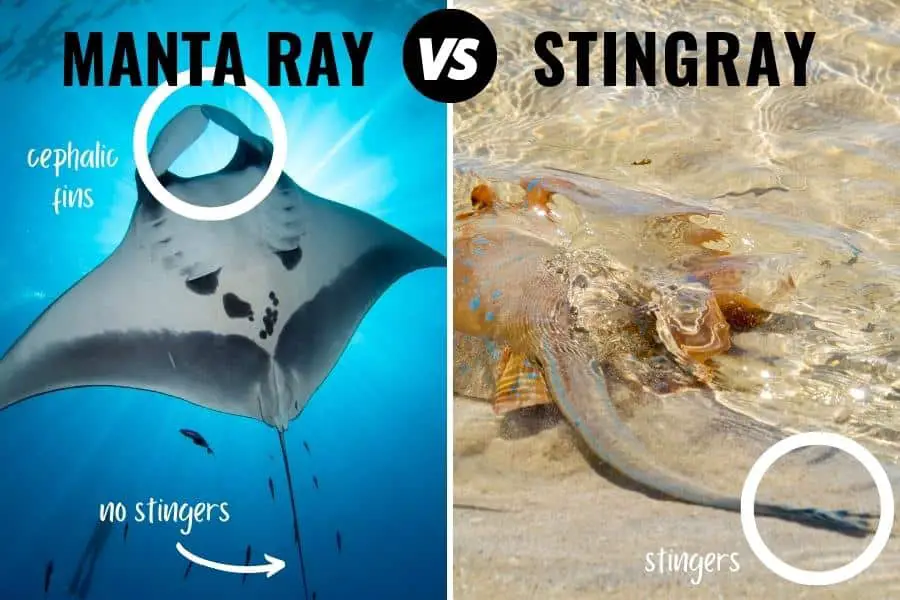
Do manta rays sting?
While mantas have a tail-like appendage, they do not have stingers or barbs on their tails. This makes manta rays less dangerous. The lack venomous sting is another way to set manta rays and stingrays apart.
Stingray vs Manta Ray: Number of species
How many stingray species are there?
There are many more stingray species compared to manta ray species in the ocean. To date there are 220 known stingrays species many of which are classified as threatened.
By this mere number alone, it is more likely to encounter stingrays compared to manta rays. I myself have encounter more stingrays than manta rays while snorkeling and diving.
How many manta ray species are there?
There are only 2 manta rays species in our ocean namely Manta birostris commonly known as the oceanic manta, and Manta alfredi, commonly known as the reef manta. In 2017, both mantas were reclassified to belong to the Mobula genus. This led to the mantas being renamed as Mobula birostris and Mobula alfredi, respectively.
Identifying manta rays from stingrays are much easier especially when there are only 2 species of mantas. However, because of its recent reclassification, it might be confusing to identify them with the other mobulas. In the past mobulas and mantas belonged to different genera. But after some DNA analysis, it was discovered that they were more similar than previously thought.
To learn more about this reclassification, read this article by Manta Trust foundation on “What are mobulids?“
Manta rays vs stingrays size
Another difference between manta rays and stingrays is their sizes.
How big are manta rays
Considered to be the largest member of the ray family, the giant oceanic manta ray (Mobula birostris) has an average wingspan of 5.2-6.8 meters (17-22 feet). The reef manta (Mobula alfredi) is the smaller manta species that has a wingspan of up to 5.5 meters (18 feet). The biggest manta ever recorded was said to be 9.1 meters or 30 feet long!
How big are stingrays?
Stingrays as adults can be as tiny as 30 centimeters (1foot) in diameter and as big as 8 feet depending on the species. The pearl stingray (Dasyatis margaritella) is said to grow only up to 30 cm, while the giant stingray (Urogymnus polylepis) is said to grow up to 2.4 meters (8 feet) across its body. This measurement doesn’t include their tails yet!
Color of manta ray vs stingray
The manta ray’s and stingray’s colorations also differ significantly. If you’re unsure of what you saw, try to recall the skin color of the creature. Manta rays are usually black and white in coloration while stingrays are often more on the brown and gray color spectrum.
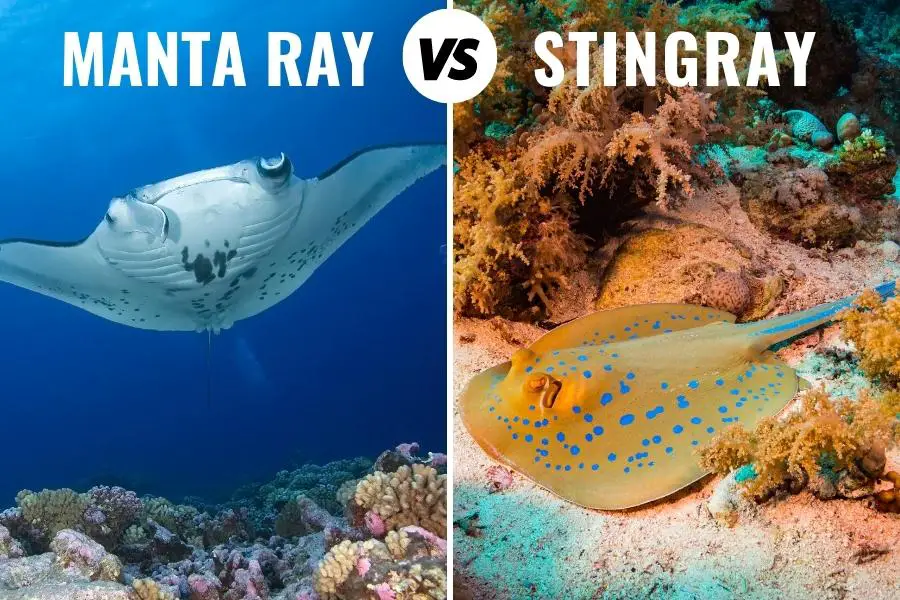
What colors are manta rays?
Manta rays come in two distinct color types:
1. Predominantly dark on top with a light-colored underbelly also known as chevron
2. Almost completely black on both sides.
Manta rays may also have distinct spot patterns on their bellies which have been very useful in identifying individual mantas.
While black and white are the most common colors on manta rays, in recent years a pink-bellied manta has been spotted in Australia. Scientists have attributed this to some sort of genetic mutation. An albino or an all-white manta ray has also been spotted in the past.
What colors are sting rays?
Stingrays come in a wide range of colors usually in the shades of browns and grays. Their skin may also have different patterns and patches to help them blend in with their surroundings. Their coloration makes the perfect camouflage while they explore and hunt their habitats
Habitat of manta ray and stingray
Another way to determine if the creature is a manta ray or stingray is identifying where you saw them. These two creatures thrive and live in different environments and habitats based on their feeding, mating and breeding behaviors.
Where can you find manta rays?
Manta rays live only in the ocean and are often found swimming in open water. They are migratory species and you can often find them in coastlines with regular upwelling. It has been observed that they visit oceanic island groups on a seasonal basis due to the abundance of food during specific times of the year.
Where can you find stingrays?
Stingrays can be found in both saltwater and freshwater environments. They are common in coastal tropical and subtropical marine waters throughout the world. Oftentimes you will see them on ocean floors where they blend in nicely with the sand. These areas are the perfect spots for when they hunt their next meal.
Manta ray vs stingray: diet
Another big difference between manta rays and stingrays is their food preferences. Manta rays are filter feeders which means they filter zooplanktons and krill out of the water. Stingrays on the other hand like to eat animals that are smaller than themselves. Their diet also explains why you can mostly find manta rays in open water and stingrays on on the sandy bottom.
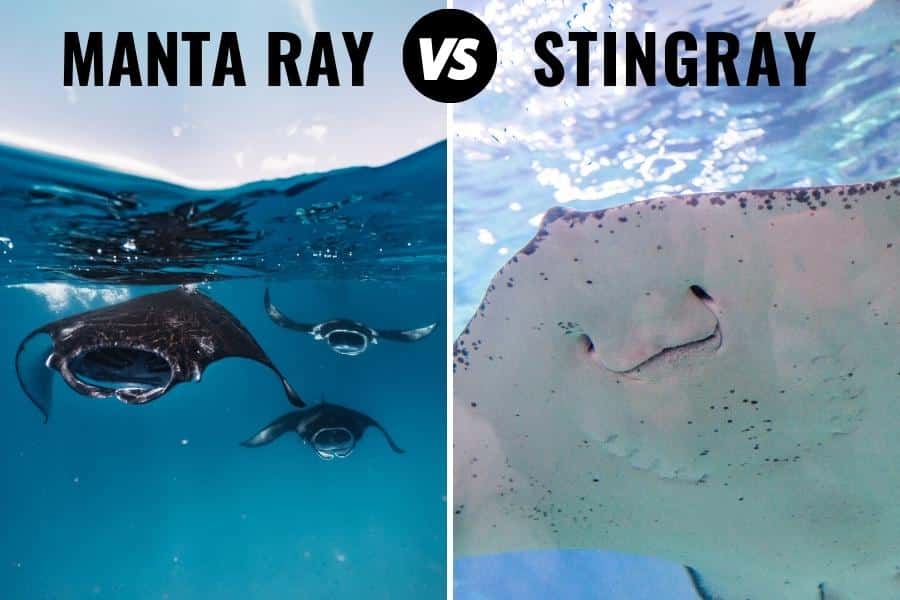
What do manta rays eat?
Manta rays love feeding on plankton which are basically tiny microscopic organisms in the sea. This usually consists of small invertebrates and fishes, as well as tiny larvae of various species. You will often find mantas in plankton-rich waters in ocean.
What do stingrays eat?
Stingrays like to eat animals like worms, clams, oysters, snails, shrimp, small fish and squid. These animals are often found closer to the reef which is why you can usually find stingrays foraging in these areas.
Hunting behavior differences between manta rays and stingrays
Aside from what they hunt and where they hunt their food, manta rays and stingrays differ with how they hunt.
How do manta rays hunt their food?
A manta ray’s mouth is located in the front portion of its body. It feeds by opening its mouth as it barrel rolls or do somersaults in the water column. Manta rays use their cephalic fins to efficiently maneuver the tiny planktons into their mouths. The plankton are then sifted through the gill plates found on the sides of their mouth.
Another interesting behavior that manta rays have is visiting cleaning stations. This is a spot on the coral reef where they go so smaller sea animals clean their skin from parasites and dead skin.
I imagine after spending some time tumbling through a plankton soup, some of the tiny organisms would have piggybacked on them and they need cleaner fishes to get them out.
How do stingrays hunt their food?
While stingrays are known for their stingers, they actually do not use it to hunt for their food. As a distant relative of the shark, stingrays also have a special electrical sensor called ampullae of Lorenzini. This can be found around the stingray’s mouth on the underside of their body. Using this organ, the stingray is able to detect the electrical charges emitted by their prey.
I’d like to think of this as their own “spidey senses” at work. Except that instead of danger it detects food! Once they sense their prey they get to work and enjoy a hearty seafood meal afterwards.
Lifecycle of manta rays and stingrays
One of the things that manta rays and stingrays have in common is that they both are ovoviviparous animals. This means that when they reproduce they develop within eggs but they carry their offsprings to term.
The stingray or manta ray babies, also known as pups, rely on the egg’s yolk for nourishment. The mother only releases them when they’re ready, giving birth to live baby rays.
While they reproduce similarly, the number of babies produced and gestation period between manta rays and stingrays also differ.
How many offsprings do manta rays have?
Female manta rays, when they get pregnant, will carry their babies to term for 12 to 13 months. The manta rays will give birth to only one to two pups at a time. You can expect the manta rays to reproduce every couple of years once it hits sexual maturity.
How many offsprings do stingrays have?
Female stingrays will carry their babies to term for 4 to 9 months. When they give birth, you can expect 1-6 pups to be born. Because of the shorter gestation period, stingrays can reproduce every year.
Once the babies are born in shallow waters, they will be left on their own to live and take care of themselves. Both stingrays and manta rays are very independent creatures and will have no trouble surviving in the wild.
Throughout their lives they tend to be solitary creatures and will only congregate as part of their mating or courtship rituals.
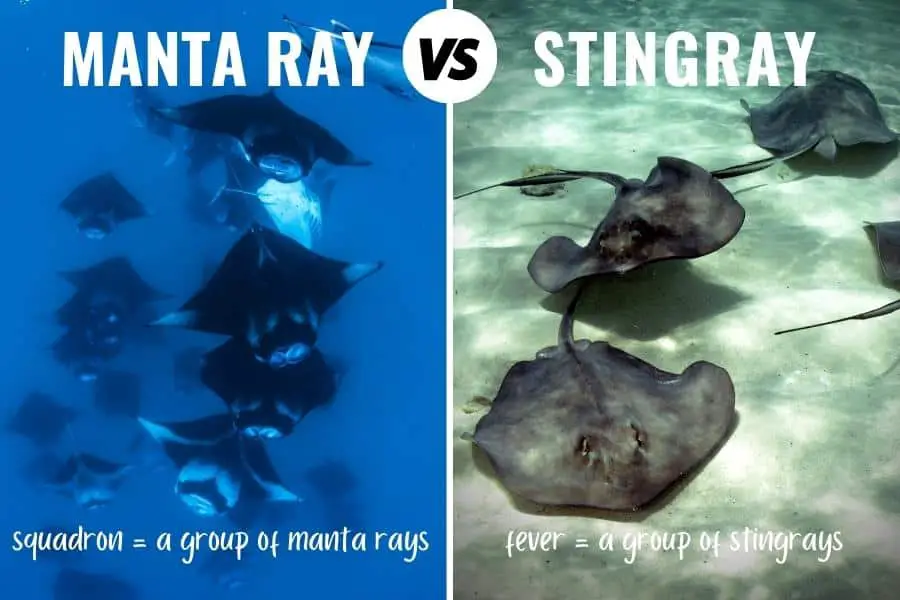
Manta rays have a long lifespan and they can live up to 40 years. Meanwhile, different stingrays species can live around 15 to 25 years in the wild.
Stingrays and manta rays: Are they dangerous?
Manta rays and stingrays are highly misunderstood sea creatures. They’re often depicted as scary and dangerous because of their size and their names. While they are predatory animals, they are not as dangerous as they seem towards humans. Oftentimes, manta rays and stingrays will retreat from humans rather than interact with them.
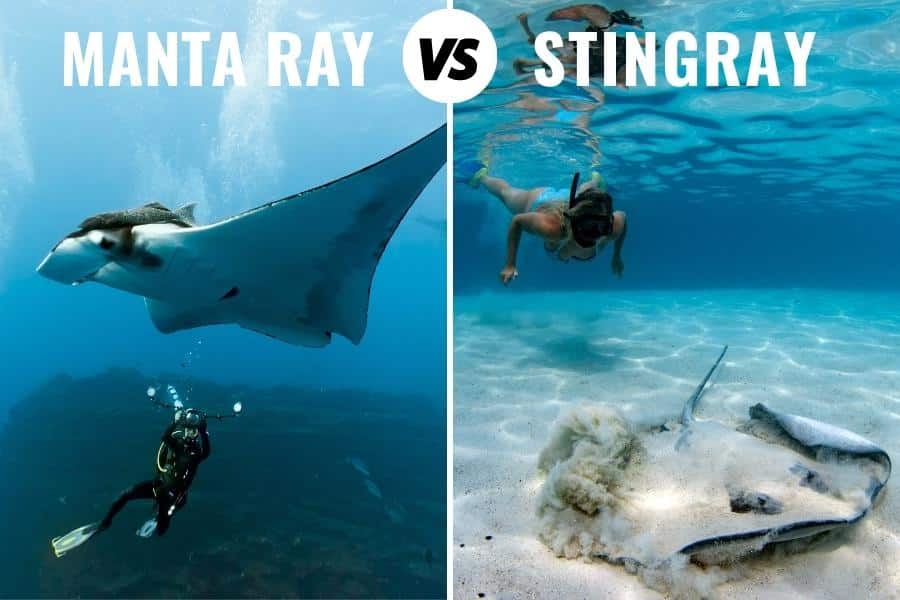
Are manta rays dangerous?
Despite their devilish looks and their massive size, manta rays are actually gentle creatures. They are harmless animals and have been observed to be very playful and smart. Interactions between humans and manta rays can be described as pleasant and safe.
Divers have even mentioned that they have seen mantas approach them out of curiosity. Occasionally they will cruise over them and get a tickle from the bubbles that the divers release when breathing underwater.
Are stingrays dangerous?
Stingrays do have venomous stingers on their tails which makes them dangerous. Their stings have resulted in serious injury or death among humans. However, these incidents are rare and the stingrays often sting humans out of defense.
Stingrays are not a species known to attack first. In fact, they are usually very docile and their usual reaction is to flee.
To avoid stingray injuries, beachgoers are often recommended to do a “stingray shuffle.” This is basically shuffling your feet on the sand, instead of taking big steps. These movements serve as a warning for stingrays and will cause them to reveal themselves and swim away.
For snorkelers and divers, if by any chance you need to kneel or stand the sand, you can also lightly waft the area with your fins first before settling down. This will reduce the chances of any stingray-related accidents.
Many places in the world like Stingray City in the Grand Caymans and Mantaray Island in Fiji will even allow you to safely interact with these creatures. You can read my personal experience swimming with manta rays, to see what it was like.
However, as visitors to their homes, you must always proceed with caution while interacting with them. They are still wild creatures that have instincts to protect themselves first and foremost.
Suggested read: 15 Dangerous Sea Creatures in the Philippines
Threats to manta rays and stingrays
Manta rays and stingrays are both predatory animals but even bigger animals prey on them too. In the wild, manta rays are hunted by larger sharks, killer whales and orcas. Stingrays are preyed upon by sea lions, sharks, seals, and other large fish.
But the biggest common threats these two creatures have are humans. Humans have always hunted manta rays and stingrays for food, medicinal purposes, and for profit.
Many cultures have dishes that use stingrays for their meat. The gills plates on these ray species are also sought after because of the high demand in the Chinese medicine market.
Manta rays and stingrays are also popular in the aquarium trade. It is very common to find these types of rays in both private and commercial aquariums.
Manta rays and stingrays also play an important role in tourism. Many countries offer snorkeling trips and opportunities to interact with these creatures. This generates millions of dollars for the local communities. While it has helped create awareness about the preservation of these creatures, mass tourism often leads to overexploitation.
Because of these threats both manta rays and many stingray species have been classified as endangered by International Union for Conservation of Nature and Natural Resources (IUCN).
Summary
Similarities between stingrays and manta rays
Distinguishing these types of rays kind be confusing because of their similarities. It is very easy for stingrays to be mistaken as manta rays and vice versa. So to recap, here are the things that stingrays and mantas have in common:
- They have similar flat body shapes with tail-like appendages.
- They are both cartilaginous fish (Chondrichthyes).
- They are both ovoviviparous animals that carry their babies in eggs and give birth to live animals.
- They are threatened marine species.
Differences between stingrays and manta rays
While they have many similarities, stingrays and manta rays have even more differences! Here are some the ways to help you tell them apart:
| Differences | Manta Rays | Stingrays |
| Stingers | No | Yes |
| Cephalic Fins | Yes | No |
| Number of Species | 2 | 220 |
| Largest Size | Up to 9.1 meters | Up to 2.4 meters |
| Dominant Color | Black and White | Browns and Grays |
| Habitat | Open water | Sandy Bottom |
| Food / Diet | Zooplankton and Krill | Smaller fish and invertebrates |
| Mouth | front of the head | underside of the head |
| Hunting Behavior | doing barrel rolls and uses their cephalic fins | uses their ampullae of Lorenzini to detect their prey |
| Gestation Period | 12 -13 months | 4 – 9 months |
| Number of pups | 1-2 per pregnancy | 1-6 per pregnancy |
| Age / Lifecycle | Up to 40 years old | Up to 25 years old |
| Harmful to humans | No | Can be |
Now that you know the similarities and differences between manta rays and stingrays, you should be able to say with confidence what exactly you saw while snorkeling or scuba diving.
Pin this for later:
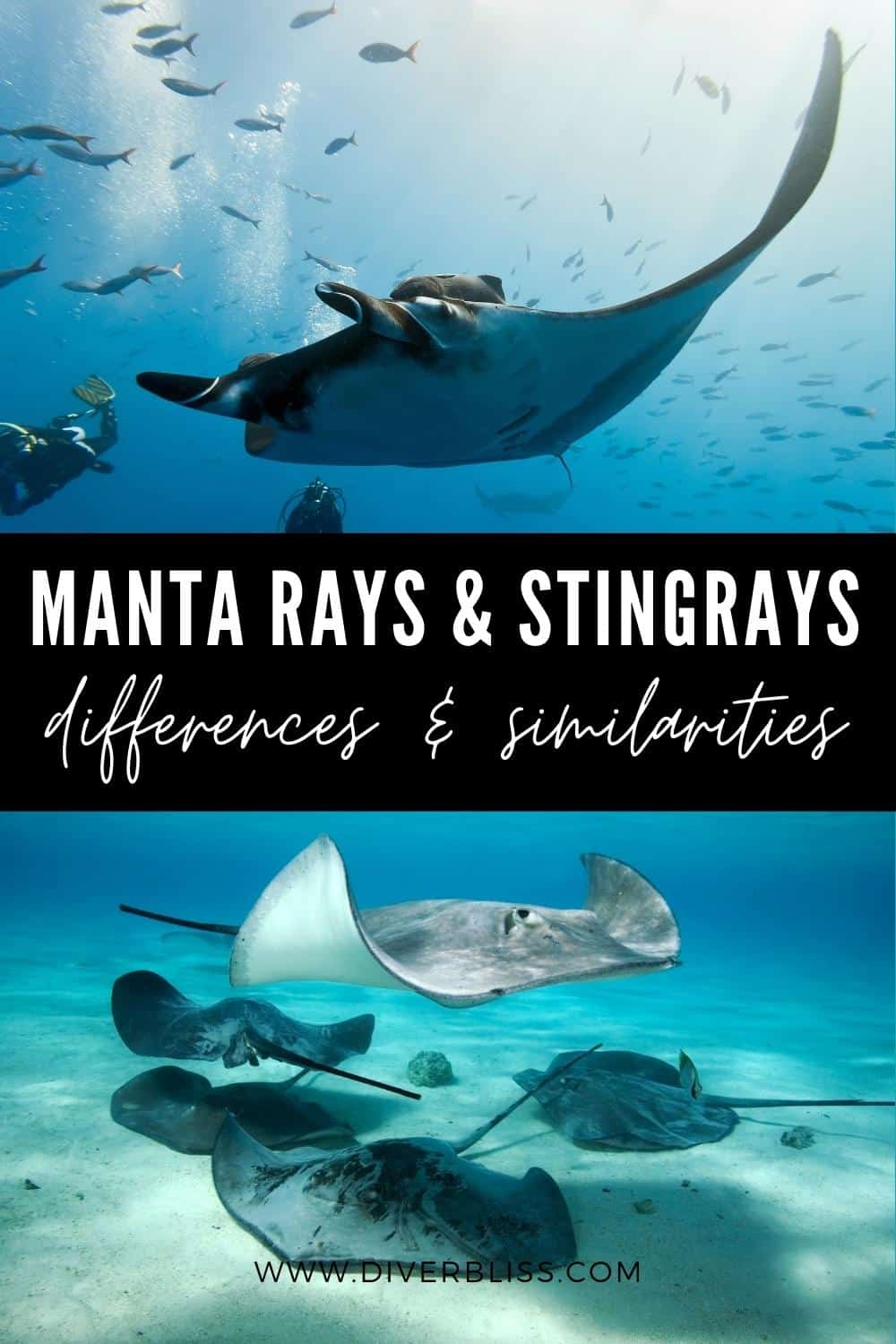
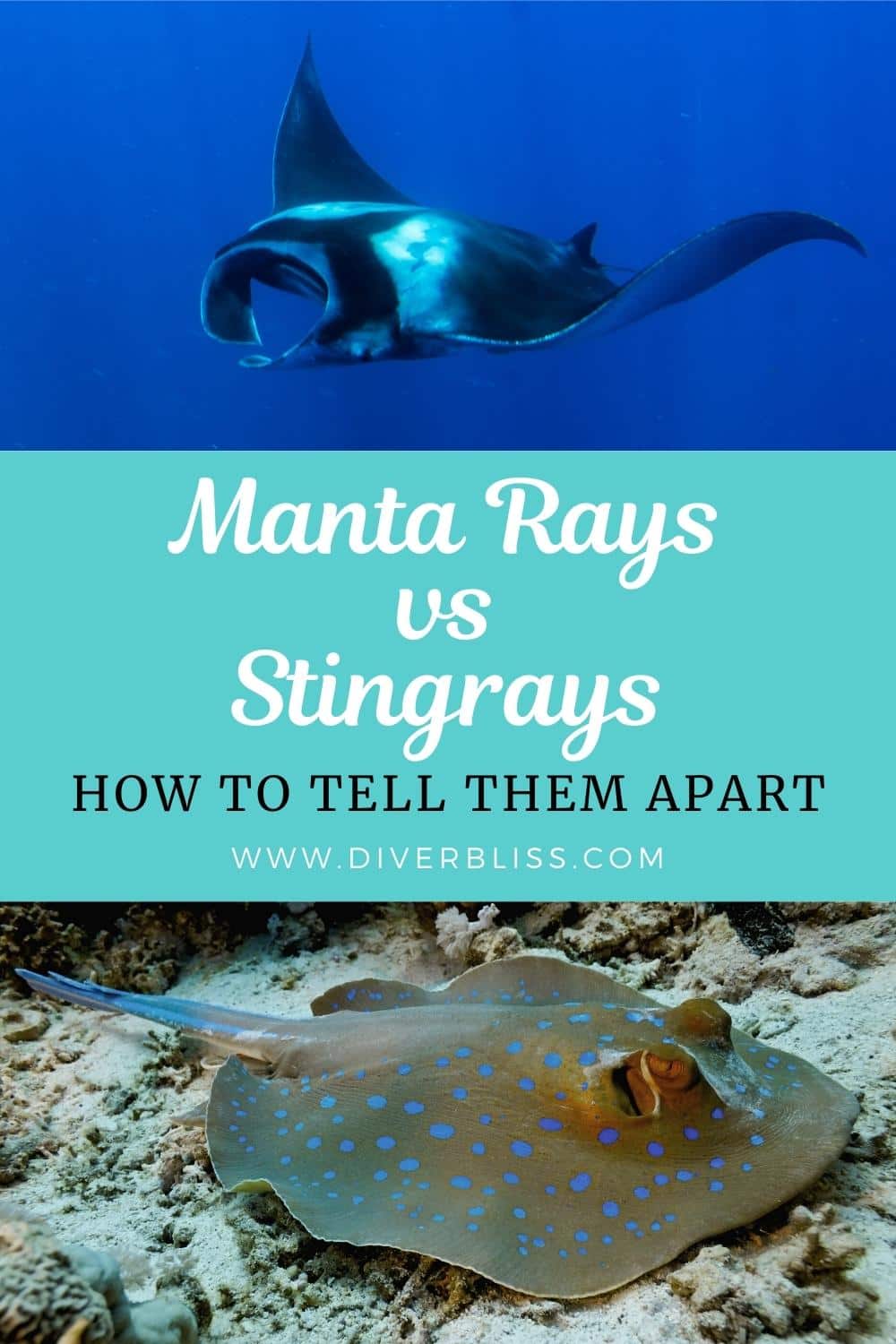
Have you seen a manta ray or a stingray in the wild? What distinct qualities do these rays have that helps you set them apart? Leave a comment below!
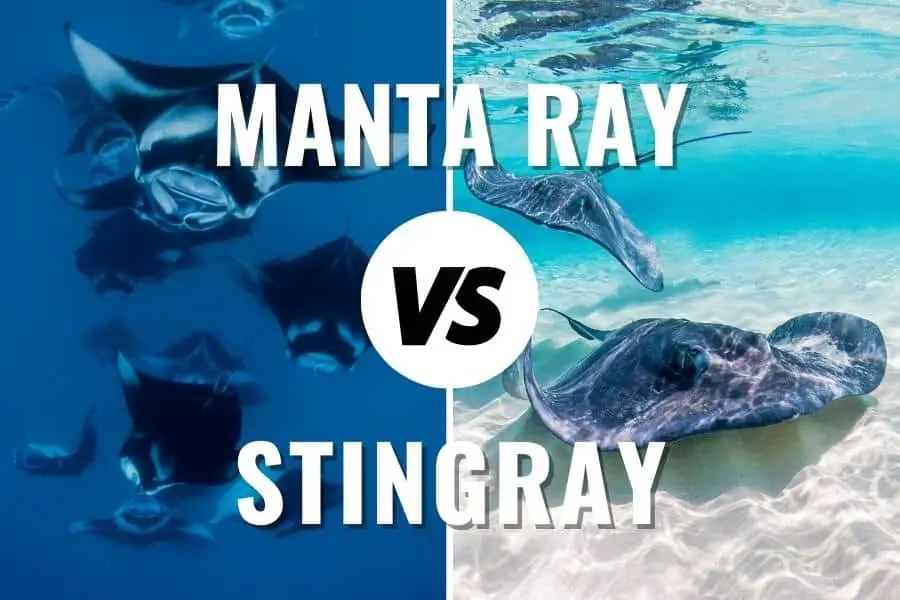

Super article and lovely pictures! I just got back from Bora Bora and didn’t know what rays we saw–and now I know! We saw a couple of squadrons and also a couple of single Manta Rays. 🙂 So amazing!